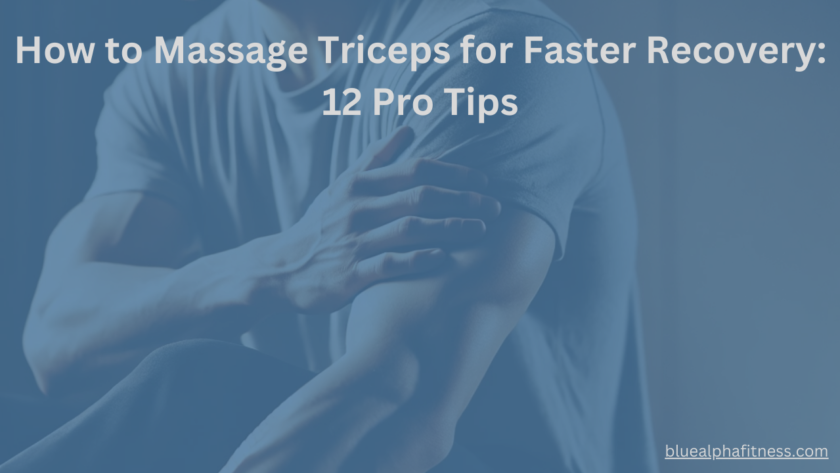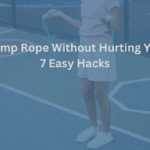After a tough workout, knowing how to massage your triceps properly can make all the difference in recovery.
If your arms feel tight and sore, it’s completely normal. Whether it’s from lifting, push-ups, or even carrying heavy bags, your triceps take a beating.
But here’s the good news: a good massage can ease tension, speed up recovery, and keep your arms feeling strong.
So, how do you massage your triceps the right way? Apply slow, deep strokes using your hands, a foam roller, or a massage gun to release tightness and improve blood flow. This helps reduce stiffness and prevents lingering soreness.
In this guide, you’ll discover the best techniques, when to use them, and common mistakes to avoid.
By the end, you’ll know exactly how to relieve triceps soreness and keep your arms pain-free.
Let’s begin.
How to Massage Triceps Properly: Techniques & Tips
As mentioned above, to massage your triceps properly, you’ll need the right techniques and tools to effectively release tension and promote recovery.
In this section, we’ll break down the essential steps, from preparing your muscles to using specific techniques, ensuring your triceps feel stronger and more relaxed
A) How to Prepare for a Proper Triceps Massage
To properly massage your triceps, start by preparing your muscles with the right warm-up and tools to ensure an effective and comfortable session.
Tip 1: Warm Up the Muscles
Before diving into any massage techniques, it’s crucial to get those triceps warmed up.
You wouldn’t start a heavy lift without a warm-up, right? The same logic applies here.
Warming up increases blood flow, making your muscles more pliable and responsive.
Think of it as prepping the dough before you knead it.
So, how do you warm up your triceps? Simple.
- Start with some light aerobic exercise – a brisk walk, a gentle jog, or even some jumping jacks.
- Aim for 5-10 minutes. You’re not looking to break a sweat, just to get the blood pumping.
- Another great option is dynamic stretching. Swing your arms in circles, or do some tricep extensions with no weights.
It’s all about getting those muscles moving and ready for what’s next.
Trust me, this small step makes a huge difference.
Tip 2: Gather Necessary Tools
Now that you’re warmed up, it’s time to gather your tools. Imagine a carpenter without their hammer – ineffective, right?
The same goes for massaging your triceps. Having the right tools is essential to getting things done efficiently.
- Foam Roller: This is your go-to for broad, sweeping pressure. It’s perfect for a general massage, covering large muscle areas with ease.
- Massage Ball: This little wonder is perfect for pinpointing those stubborn knots and tight spots. Think of it like a laser for your muscle tension.
- Massage Stick: Consider this for more control and precision. You can apply pressure exactly where you need it without relying on your body weight.
Having these tools at hand can make the whole process smoother and more effective.
You’ll be hitting those triceps like a pro in no time.
B) Self-Massage Techniques for Triceps Relief
Mastering self-massage techniques allows you to target tight spots and relieve tension in your triceps, promoting faster recovery and muscle relaxation without needing a professional.
Tip 3: Foam Rolling
Foam rolling is a staple in the world of muscle recovery. It’s like the Swiss army knife of self-massage techniques – versatile and effective.
Here’s how you can use it to relieve your triceps:
- Place the foam roller on the floor and lie down on your side
- Extend your arm, placing your triceps on the roller
- Using your body weight, slowly roll from your elbow up to your shoulder.
- Move back and forth, applying steady pressure.
- If you find a particularly tender spot, pause and let the roller sink in for a few seconds.
This technique works wonders because it helps release muscle tension and improves blood circulation.
It’s like giving your triceps a much-needed break after all those heavy lifts.
Plus, the broad pressure from the roller can cover more area, making it an efficient way to start your massage routine.
Tip 4: Massage Ball Pressure Points
Now, let’s get into the nitty-gritty with the massage ball.
This tool is perfect for targeting specific pressure points in your triceps.
- Start by placing the massage ball between your triceps and a hard surface, like a wall or the floor.
- Gently press your arm into the ball, rolling it around until you find a tender spot.
- Once you hit that spot, hold the pressure for about 20-30 seconds.
This method is all about precision.
It’s like a sniper shot compared to the shotgun approach of the foam roller. By zeroing in on those tight knots, you can release tension that might otherwise go unnoticed.
This technique is especially useful after a particularly grueling workout, when your muscles are tight and sore.
Tip 5: Cross-Fiber Friction Massage
Cross-fiber friction massage might sound fancy, but it’s a straightforward technique that packs a punch.
To do this, use your fingers or a massage tool to apply pressure perpendicular to the muscle fibers.
Imagine you’re rubbing the triceps across the grain. This technique breaks down scar tissue and adhesions, promoting better flexibility and healing.
For example, if you’re using your fingers, press firmly into the triceps and move back and forth across the muscle.
You’ll feel the fibers beneath your skin, and you might notice some tender spots. Focus on those areas, working slowly and methodically.
This technique can feel a bit intense, but that’s a sign it’s working.
Breaking down those adhesions helps restore proper muscle function, making your triceps more resilient and flexible.
Tip 6: Static Compression
Static compression is a game-changer for releasing deep muscle tension.
It’s simple, effective, and you can do it almost anywhere.
Here’s how:
- Find a tight spot in your triceps using a massage ball or your fingers.
- Apply steady, firm pressure and hold it there.
- Don’t move, just keep pressing for about 20-30 seconds.
- You might feel the muscle start to relax and release under your touch.
This technique works because it forces the muscle to release tension by maintaining constant pressure.
It’s like pressing a reset button for your triceps.
Plus, it’s a great way to finish your self-massage routine, leaving your muscles feeling relaxed and rejuvenated.
C) Assisted Massage Techniques for Triceps Relief
When self-massage isn’t enough, assisted techniques—whether with a partner or a professional—can provide deeper pressure and more targeted relief for your triceps.
Tip 7: Partner-Assisted Massage
Sometimes, a friend’s help is all you need.
Partner-assisted massage can be incredibly effective, especially for those hard-to-reach areas.
Here’s how it works:
- Have your partner use their hands or a massage tool to apply pressure and massage your triceps
- You can guide them to the spots that need the most attention, ensuring they hit all the right areas
- For example, lie down on a comfortable surface and extend your arm
- Have your partner use their thumbs to apply pressure along your triceps, starting at the elbow and working up to the shoulder
- They can use circular motions or follow the muscle fibers, depending on what feels best for you
Having a partner can provide more precise pressure and reach areas that are difficult to self-massage.
Plus, it adds an element of relaxation, allowing you to fully enjoy the benefits of the massage without straining yourself.
Tip 8: Professional Sports Massage
Sometimes, it’s best to bring in the experts.
A professional sports massage therapist has the skills and knowledge to give your triceps the deep tissue work they need.
When you book a session, make sure to communicate your needs clearly. Let the therapist know you’re a lifter and your triceps need special attention.
They’ll use techniques like deep tissue massage, myofascial release, and trigger point therapy to work out any knots and tension.
A professional massage isn’t just about relaxation – it’s about targeted, effective treatment.
The therapist can assess your muscle condition and tailor the massage to your specific needs.
And this can lead to better recovery, improved performance, and a reduced risk of injury.
D) Stretching and Post-Massage Care for Triceps Recovery
Incorporating stretching and proper post-massage care helps maintain flexibility, prevent tightness, and enhance the benefits of your triceps massage.
Tip 9: Do Static Stretching
Stretching is the cherry on top of your massage routine.
It helps lengthen the muscle fibers and improves flexibility.
- After your massage, perform some static stretches for your triceps.
- Extend one arm overhead and bend the elbow, reaching for your back.
- Use your other hand to gently push the elbow back, deepening the stretch.
- Hold for 30 seconds, then switch arms.
This stretch helps to elongate the triceps, counteracting the shortening that happens during workouts.
It’s a simple but effective way to maintain flexibility and prevent tightness.
Tip 10: Proper Hydration
Hydration is crucial for muscle recovery.
Drinking plenty of water before and after your massage helps flush out toxins released during the massage and keeps your muscles hydrated.
Think of your muscles like a sponge.
When they’re well-hydrated, they’re more pliable and less prone to injury.
So, grab that water bottle and make sure you’re drinking enough throughout the day.
Tip 11: Apply Heat Therapy
Heat therapy is another excellent post-massage practice.
Applying heat to your triceps can further promote blood flow and muscle relaxation.
- Use a warm towel or a heating pad and apply it to your triceps for about 15-20 minutes.
- The warmth helps to relax the muscle fibers, easing any residual tension and enhancing the effects of your massage.
Heat therapy can be especially beneficial after a tough workout or if you’re dealing with chronic muscle tightness.
It’s a simple, soothing way to give your triceps a little extra love.
Tip 12: Consistent Routine
Consistency is key when it comes to muscle health.
Therefore, incorporate these massage techniques into your regular workout recovery routine to keep your triceps in top shape.
Make it a habit to massage your triceps at least a couple of times a week.
Regular massage helps maintain muscle health, prevents injuries, and enhances performance. Plus, it feels great – a little self-care goes a long way.
By sticking to a consistent routine, you’ll notice improvements in your muscle flexibility, reduced soreness, and overall better performance in the gym.
It’s a small time commitment that brings big benefits down the line.
FAQs: How to Massage Triceps (Your Top Questions Answered)
Now that you’ve learned the tips, let’s tackle some of the most common questions you might have about how to massage triceps effectively.
1. How do you release tension in your triceps?
You release tension in your triceps by using self-massage techniques such as foam rolling, using a massage ball, or applying static compression. These methods help to loosen tight muscle fibers and improve blood flow.
2. How to relieve triceps pain after a workout?
To relieve triceps pain after a workout, use a combination of stretching, massage, and heat therapy. This helps to reduce muscle soreness and promote recovery.
3. How can I heal my triceps fast?
To heal your triceps fast, incorporate rest, proper hydration, stretching, and massage into your routine. These practices aid in reducing inflammation and speeding up the recovery process.
4. What causes tight triceps?
Tight triceps are caused by overuse, improper form during exercises, and inadequate stretching. These factors lead to muscle tension and reduced flexibility.
5. What is the most effective triceps exercise?
The most effective triceps exercise is the triceps dip. This compound movement effectively targets all three heads of the triceps for maximum muscle engagement.
6. Why is training triceps hard?
Training triceps is hard because they are often secondary muscles in many compound exercises. This can lead to them being fatigued before isolation exercises, making it challenging to fully exhaust the muscle.
7. Why do triceps grow faster than biceps?
Triceps grow faster than biceps because they make up a larger portion of the upper arm and are involved in more compound movements. This increased workload promotes faster muscle growth.
8. How do you get the perfect triceps shape?
You get the perfect triceps shape by incorporating a variety of exercises that target all three heads of the triceps. Consistent training and proper form are key to achieving balanced muscle development.
9. Which is stronger, biceps or triceps?
Triceps are stronger than biceps. They consist of three muscle heads compared to the biceps’ two, allowing for greater overall muscle mass and strength.
10. How to get big triceps fast?
To get big triceps fast, focus on heavy compound exercises like triceps dips and close-grip bench presses. Include isolation exercises such as triceps extensions and pushdowns to target all three heads of the triceps. Ensure progressive overload and proper nutrition to support muscle growth.
Mastering How to Massage Triceps for Lasting Pain Relief
Are you still with me? Perfect!
Unlocking relief for your aching triceps is within reach.
You’ve felt the frustration of post-workout soreness, but imagine a future where that pain is a thing of the past. It’s natural to wonder if these tips will truly work, but trust in the power of consistency.
With each technique, you’re not just massaging muscle – you’re sculpting resilience.
Picture the energy you’ll regain, the performance gains you’ll make, and the joy of pushing boundaries without hesitation.
You’re not just another lifter; you’re someone on a journey to greatness.
Embrace the process, and watch as your triceps transform before your eyes. The path to stronger, healthier muscles starts now.
You’ve got the drive, the determination – let’s make it happen together!



